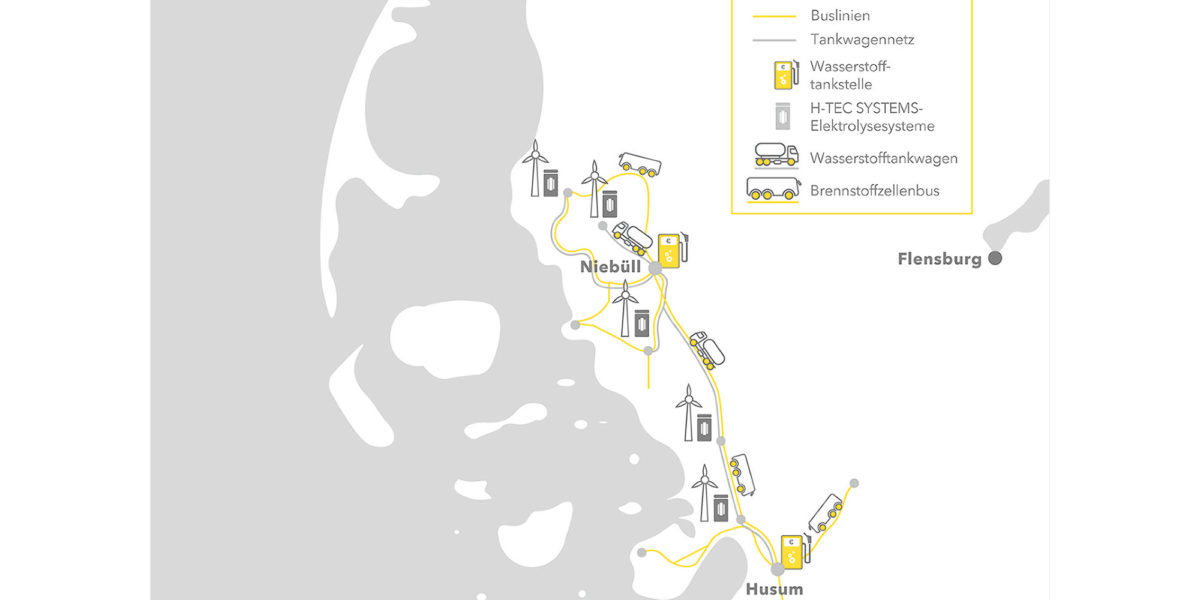From pv magazine Germany.
German lender GLS Bank, plus regional partners VR Bank Westküste eG and Nord-Ostsee Sparkasse, have agreed to finance the ‘eFarm’ hydrogen transport pilot project in North Friesland with an initial €7.4 million.
With the German Ministry of Transport set to stump up €8 million for the scheme, being planned by German developer GP Joule, the bank consortium plans to assign a further €4.4 million further down the line.
Approved in late 2018, the project involves GP Joule developing complete hydrogen transport infrastructure to power two fuel-cell buses and five cars. Under the initiative, five wind farms in the region will power green hydrogen production to be delivered to filling stations in Husum and Niebüll.
Heat generated during the production of green hydrogen will also be fed into local heating networks.
“With the e-farm, we [will] create additional added value from renewable energies on-site, where they are generated,” said GP Joule chief executive Ove Petersen. “This strengthens acceptance for the further expansion of wind and solar power and shows that everyone in the region can benefit directly from the energy transition.”
This content is protected by copyright and may not be reused. If you want to cooperate with us and would like to reuse some of our content, please contact: editors@pv-magazine.com.




What amount of hydrogen energy is used by these vehicles compared to the solar energy produced?
A pretty simple question that never seems to get answered???
The lies and obfuscations of the ultra-powerful renewables lobby, backed by fossil fuel capital (as ‘Planet of the Humans revealed) are coming home to roost through green hydrogen.
It is the only way – the one and only way – of ‘curing’ the ‘Intermittency Problem’. But what it’s possible to do then, for the UK, is work out the capital cost, environmental impact, material use and waste mountains of a possible combination of biomass, wind and solar. It doesn’t matter how the CCC or National Grid want to play about with any other combination – the answers will still be the same or worse. And that’s just for – Intermittent Electricity – it doesn’t cost in the salt cavern storage and P2G2P infrastructure needed on top of that, to guarantee 24/7/365 electricity diurnally and seasonally.
Starting today, for the UK to get to zero carbon by 2050, using renewables and green carbon, will have a capital cost of £170 billion per year, for 30 years to 2050. That’s 6% of GDP which will bankrupt the UK. The ‘Renewables Fallacy’ in stark figures, puts a stark message to Government to shun those that have lied their ways into your policy framework.
On the other hand, combining green hydrogen production with advanced nuclear power plants, to replace all natural gas and petroleum using ammonia and synfuels, is manageable by 2050. The most cost effective SMR, operational in 2027 and available in the UK by 2030, is the 300 MW, GE Hitachi BWRX-300. Starting in 2030, the cost would be £50 billion per year, for the 20 years to 2050 – that’s under 2% of GDP – and that would be for 24/7/365 generation, requiring no backup.
Even considering the more expensive Rolls-Royce 440 MW SMR, with the first one operational in 2029, the capital cost would still be 40% less than renewables – £105 billion per year, and for just 20 years – and again, no backup.
Search for: bwrx-300 blogspot
Hi Colin,
Thanks for your comment. Given you say the renewables lobby is ultra-powerful, it seems to be doing a pretty poor job of getting us to 100% renewables, doesn’t it?
Please help us understand why solutions such as pumped hydro storage, gravity storage and battery storage do not solve the intermittency problem. Also, it would be useful to have an example of some of the lies you refer to here, so that they can be exposed, as we take accusations of fake news very seriously here at pv magazine.
Finally, have you factored in the insurance and government-funded clean-up costs into that £50 annual figure you quote? And where will you put the resulting waste materials, which I presume you’ve also factored into your annual cost figure, right?
@bfearn
No solar energy is produced. What is your question?
Solar energy is 22% efficient. Electrolysis is 80% and fuel cell is 50% efficient.
Does this answer it?